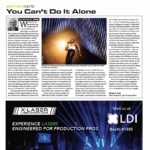“There were no limits to the imagination and no limits to creativity.” —Peter Morse, LD for Michael Jackson’s later tours
By the time you read this, most of you will have had your fill of the media’s coverage of the untimely demise of a certain King of Pop. But the industry owes him a great debt of gratitude for setting the high mark in production standards.
Few performers have ignited the flames of inspiration and creativity as did this one, and the live event production industry will never be the same after his considerable influence.
In case you missed it — in case you were living in a cave in Afghanistan or if you were born in the third millennium — Michael Jackson almost single-handedly transformed the live concert from a caterpillar to a full blown Monarch butterfly. His 1982 album Thriller was largely responsible for ushering in the age of MTV when it was truly Music Television and not just reality television programming. If you were not around to witness it firsthand, it was kind of like that moment in The Wizard of Oz when the screen went from black and white to color. It was as if we never knew, up until that point, that production could be totally immersed in the dynamics of lighting, sets and choreography.
During his heyday, he continually pushed the envelope and often paid the price. In 1984 he suffered second degree burns after a pyro accident set his hair on fire. Several times he suffered broken bones, including his nose, and other dance- or production-related injuries.
But that didn’t deter him. Later in 1984 year he co-wrote We Are the World with Lionel Richie and helped spur live concert charity events like Live Aid. From 1987 to 1989, his Bad world tour played to a world record 4.4 million people over 123 shows. In 1992 and 1993 his Dangerous world tour played to 3.5 million people in 67 shows. At the end of that tour he performed a live show during the halftime of Super Bowl XXVII and it became the first Super Bowl in which the viewership actually increased during the halftime show.
Peter Morse was the lighting designer on every one of MJ’s tours since Dangerous. He was in the shotgun seat during the peak of MJ’s career.
“There is no question,” Morse said, “that Michael Jackson, via his Dangerous and HIStory tours, had a major influence on technological advancements in the lighting industry at that time. While Michael was certainly the consummate entertainer, he also possessed a keen ‘sixth sense’ for lighting and special effects that would complement his performance. His requests sometimes seemed undoable — simply unrealistic. However, his performance motivated us to find solutions and products that, at that time, either simply didn’t exist or were only in the prototype stage of development. For me, he was certainly a lighting designer’s dream come true. There were no limits to the imagination and no limits to creativity. Indeed, despite the unbelievable amount of lumens created around him, he was never lost. Instead, his performance was only enhanced.
“An example: His continued requests for more and more ‘white light’ led us to implement xenon technology (via Xenotech) in ways that had not as yet been utilized. (This was, of course, before the days of Syncrolite and similar companies).
“There was never a fear of upstaging him with our effects. He knew instinctively that, for all the lighting that surrounded him, he was still by far the brightest light of all.”
Someone once said that the worst thing that can happen to a man is to win the lottery at an early age. Michael Jackson won the record industry lottery when he was 11 years old with the Jackson 5, when they recorded the number one hit, “I Want You Back.” It’s unfortunate that his many accomplishments will be marred by his questionable behavior. Ultimately it may have cost him his life. But it can’t erase the considerable contributions he made to the live event production industry, and for that we’re grateful.


